Food
Everything you need to know about sake
by Leanne Bracey
The youth of Japan see sake as an old person's drink, but over here, our demand for Japanese restaurants is growing and growing and so is our thirst for the drinks that go with the food and culture. Here are a few things I've learnt about Japan's most famous drink...
Where can I taste it?
With a plethora of Japanese restaurants popping up everywhere, there are plenty of places to try it.
- At an amazing sushi and sake private dining experience in Tokyo earlier on this year (yes, I'm very lucky) I tried a delicious sparkling sake and I was all poised to head to the local store to buy some before I came home. Sadly it was a limited edition and unavailable outside their four walls but I did recently spot a very similar one in Selfridges... hooray!
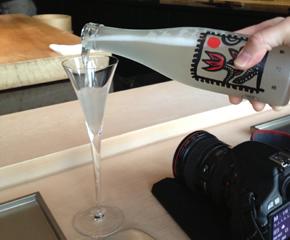
This is the sake I had at Sushi SORA at Mandarin Oriental, Tokyo. Selfridges sells a very similar-looking one
- Sake pairs well with sweet things, so for a real luxury treat go to Mandarin Oriental, Hyde Park, London and book in for afternoon tea at The Rosebery where you can try 3 sake varieties to complement the different parts of the afternoon tea. Yum. The afternoon tea at The Rosebery is the best I've had in London.
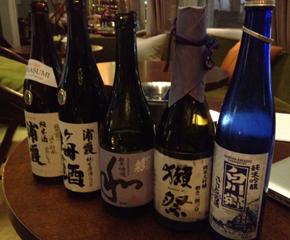
A selection of sake served at The Rosebery, all at a different price point but all very delicious
- A good starting sake is a sparkling brand such as MIO. It's reasonably priced and a good introduction to the flavours. The MIO brand is the biggest national company producing sparkling sake and as a modern brand they are producing modern sake to make it popular in the UK.
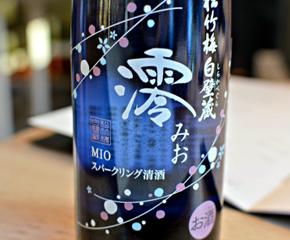
MIO Sparkling sake
Where can I buy it and what should I look out for?
The best place is The Japan Centre online or at London's Piccadilly Circus. Or try The Fine Wine Company and The Ministry of Drinks. Sake selections can be pretty vast and daunting for the first-time buyer so you could leave feeling more confused. Why not go to the Hyper Japan festival at The 02 in London in July? Here you can try a whole range of sakes and Japanese liqueurs.
If you're making a purchase, there are certain things to look out for.
1.
Look at the percentage of grain polishing.
This tells you the quality of the sake as the more of the outer layer of rice that's polished away (70% being high, 40% being low), the more expensive the sake. So the number on the bottle is not the alcohol content, it's the grade and polishing ratio.
2. There are 5 main types of sake
Futsu-shu – standard everyday drinking sake and doesn't fit within the premium sake categories. For this there is no minimum rice polishing required.
Honjozo – has a small amount of alcohol added. It's light and dry and crisp. 61-70%. Addition of alcohol makes this kind cleaner and crisper. You can drink this warm/hot. Around £15-20.
Junmai – 61% +. Rounder and full bodied, slightly more complex. Serve warm or hot. Like Chardonnay or Pinot Noir. Around £20-30.
Ginjo – 51-60%. Light and fresh. Brewer's distilled alcohol added. Aromatic and spicy. Drink this chilled. Like a Chenin Blanc or dry Reisling. Around £20-30.
Junmai daiginjo – 50%. Light and smooth. Fruity in flavour. Like a Sauvignon Blanc or Viognier. Around £25-50+.
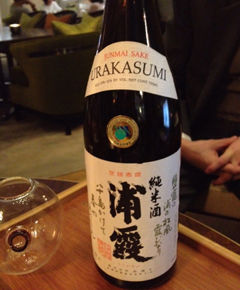
Junmai Sake bottle
3. Look at the filtering
Sake can be clear or cloudy but all sake has to be filtered because of legal requirements. It all depends on the producer. Cloudy coloured sake sometimes has the wrong term written on the label which might say 'unfiltered sake'. But sake has to be filtered somehow in order for it to be called sake! If your sake has a creamy colour to it, the producer has decided to add some sediments back into it to give it this appearance. If you want to try this kind of sake look for the term 'Nigori' on the label – just make sure you mix the bottle sediment.
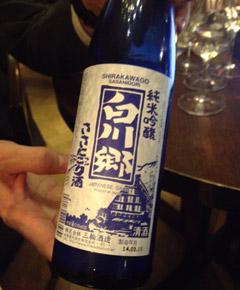
A label showing a 'Nigori' cloudy sake
4.
Look at the date.
Unlike wine, sake doesn't age well. Keep it in the fridge ideally around - 10-12°C and try to drink it within 16 months.
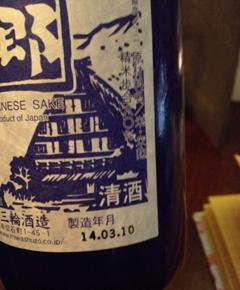
A sake label showing the date produced
It's worth noting that sake is a seasonal drink – the rice is planted in spring, grown over summer, and most producers would start making it in the autumn right after the harvest of the rice. The first sake would come out in the market around November/December time. So look at the date, year and month on the bottle, and try to buy it as fresh as possible. The end of a year to early summer is the best time to drink freshly brewed sake. Try looking for un-pasturised sake which is labelled 'Nama' or "Namazake'.
How do I drink it?
Even though it's mainly served in little glasses, you're not meant to down it in one and drink it like a shot. Depending on the type of sake you can either have it hot or cold (as explained above).
Changing the temperature really just gives you a different impression of the sake. As a general rule of thumb, the less the grain has been polished, the more you'll want to change the flavour so probably best heat those cheaper ones up but remember, the heat will make you feel more tipsy!
Go for the Junmai or Honjozo type to try it warm, or at room temperature. If the sake is better quality, you'd only taste the alcohol upon heating it up. Go for a Daiginjo style if you prefer a cold drink. The best way to warm it is in a hot water bath or use a microwave.
Back to the glasses as they are an important part of sake culture. A little wooden box used to be a traditional way of drinking it but they're not so practical these days. When you're at a sake event you will choose your 'vessel'. Always pour with two hands to show respect and don't top up your own glass.
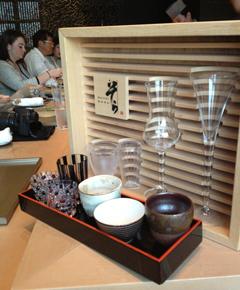
Beautiful sake glasses in Tokyo
What do I eat it with?
The Japanese say "Nihonshu wa ryori wo erabanai" meaning "sake doesn't get into fights with food."
Sake is a really adaptable drink and by all means shouldn't just be paired with Japanese food. Compared with wine, you can never really have a bad food combination with this drink, so you can actually have it with lots of things although generally you'd have cold sake with food. Because it has a short crisp and dry finish, it's great as a palate cleanser and also cuts through any oiliness in food, therefore, it's great with charcuterie and duck.
Try the Ginjo-ka variety with fragrant herbal dishes such as pesto, ceviche or Vietnamese food. Try 'Nama' sake (as mentioned before) with roasted, nutty and caramelised flavours such as a crème brûlée. The Diajngo variety matches well with goats and blue cheese.
Cloudy 'Nigori' sake is good with lamb cutlets, spicy food and cheesecake as well as tropical fruits.
Do you have any sake tips? Leave us a comment below.












